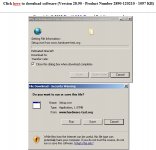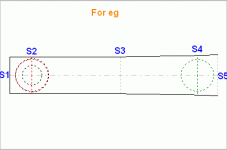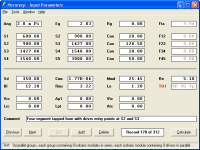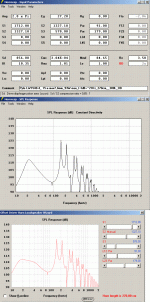Thank you for your quick reply to my question about where I can get Hornresp.
Tried to download it, but got a warning on my screen that "it could harm my computer". What did I do wrong?
You have not done anything wrong. You can download and install Hornresp with confidence!
You can always check the files with your virus scanner before installing.
Attachments
Hi David,
Just saw Post #2578, and tried your new isobaric feature. It seems to work quite well, and is so easy to use. This will come in handy.
Maybe one more suggestion: how about adding a button for the number of isobaric pairs? Would that be easily possible?
Thank you so much for your continuous effort.
Regards,
Just saw Post #2578, and tried your new isobaric feature. It seems to work quite well, and is so easy to use. This will come in handy.
Maybe one more suggestion: how about adding a button for the number of isobaric pairs? Would that be easily possible?
Thank you so much for your continuous effort.
Regards,
Last edited:
Hi Oliver,
Please remember, for the reasons given in Post #2540, that the Hornresp isobaric model ignores the effect of the air volume between driver diaphragms. As can be seen from the attachment to Post #2540 however, this simplification to the model makes very little difference to the overall results at bass frequencies, where the dimensions of the enclosed air volume are small compared to the wavelength.
The current functionality allows for up to nine drivers to be connected in series or parallel in an isobaric configuration. If this can be reduced to just two drivers, then perhaps it may be possible - I would need to investigate further.
Could you please confirm that multiple isobaric pairs are all that would ever be required, and that "isobaric triplets", for example, would never be needed.
Kind regards,
David
Just saw Post #2578, and tried your new isobaric feature. It seems to work quite well, and is so easy to use. This will come in handy.
Please remember, for the reasons given in Post #2540, that the Hornresp isobaric model ignores the effect of the air volume between driver diaphragms. As can be seen from the attachment to Post #2540 however, this simplification to the model makes very little difference to the overall results at bass frequencies, where the dimensions of the enclosed air volume are small compared to the wavelength.
Maybe one more suggestion: how about adding a button for the number of isobaric pairs? Would that be easily possible?
The current functionality allows for up to nine drivers to be connected in series or parallel in an isobaric configuration. If this can be reduced to just two drivers, then perhaps it may be possible - I would need to investigate further.
Could you please confirm that multiple isobaric pairs are all that would ever be required, and that "isobaric triplets", for example, would never be needed.
Kind regards,
David
@ David McBean
Hi & thanks for continually improving HR
I'ld like to suggest a couple of things that, i for one would LOVE to see included.
First of all, being able to see labels for, at least S1 - S5 that followed Instantly with the ongoing design changes, would make it Immediately apparent which sliders were about to correspond with which dimension, & then did in real time.
Also it would be useful to be able to view the Baseline Schematic for comparison. It's great that we can view the Baseline graphs for various parameters, but not unfortunately the Schematic. This could be a toggle on/off as present, & in a different colour to differentiate.
TIA
Hi & thanks for continually improving HR
I'ld like to suggest a couple of things that, i for one would LOVE to see included.
First of all, being able to see labels for, at least S1 - S5 that followed Instantly with the ongoing design changes, would make it Immediately apparent which sliders were about to correspond with which dimension, & then did in real time.
Also it would be useful to be able to view the Baseline Schematic for comparison. It's great that we can view the Baseline graphs for various parameters, but not unfortunately the Schematic. This could be a toggle on/off as present, & in a different colour to differentiate.
TIA
Attachments
Hi David,
Post #2583: "...Could you please confirm that multiple isobaric pairs are all that would ever be required, and that "isobaric triplets", for example, would never be needed."
I cannot. While I might consider using two (cheap) drivers in an isobaric pair, I dont' think I am interested in using three (now not so cheap) or more drivers like that; but, as a general question, I cannot forsee what might come up.
As it is now, Hornresp allows for a quick look at an isobaric pair (in series and parallel connection) in any of the enclosure types. Add to that the ability to stack up any number of drivers - that's just great.
Regards,
Post #2583: "...Could you please confirm that multiple isobaric pairs are all that would ever be required, and that "isobaric triplets", for example, would never be needed."
I cannot. While I might consider using two (cheap) drivers in an isobaric pair, I dont' think I am interested in using three (now not so cheap) or more drivers like that; but, as a general question, I cannot forsee what might come up.
As it is now, Hornresp allows for a quick look at an isobaric pair (in series and parallel connection) in any of the enclosure types. Add to that the ability to stack up any number of drivers - that's just great.
Regards,
I'ld like to suggest a couple of things that, i for one would LOVE to see included.
Hi Zero D,
While I understand the reasons for your suggestions, they would require a lot of work to implement - more than I can justify for the benefit to be gained.
Sorry, its not going to happen
Kind regards,
David
As it is now, Hornresp allows for a quick look at an isobaric pair (in series and parallel connection) in any of the enclosure types. Add to that the ability to stack up any number of drivers - that's just great.
Hi Oliver,
I have come up with a way of permitting up to nine drivers to be specified in a series or parallel isobaric module (even though it is highly unlikely that more than two would ever be needed), while also allowing for multiple isobaric modules to be specified, as you have requested.
The new input parameters window will appear as shown below. The lower case 'p' in '9P 9S 9p' is intentional - it enables Hornresp to identify the configuration of the isobaric module (in this case, 9 drivers connected in parallel).
Because of the amount of work involved, it will take me some time to implement the necessary changes.
Kind regards,
David
Attachments
@ David McBean
That's a pity At least having the Baseline Schematic for comparison would be VERY useful Indeed.
At least having the Baseline Schematic for comparison would be VERY useful Indeed.
I understand you're busy though, so if you aren't able to do it, or them now, hopefully you will consider doing so at some point, if it's possible that is
Regards
That's a pity
I understand you're busy though, so if you aren't able to do it, or them now, hopefully you will consider doing so at some point, if it's possible that is
Regards
Is it possible that Hornresp could show electrical phase?
Hi Dan,
Electrical phase values can be sampled and/or exported for plotting.
This is probably as good as it is going to get
Kind regards,
David
Hi Dan,
Electrical phase values can be sampled and/or exported for plotting.
This is probably as good as it is going to get.
Kind regards,
David
Thanks for the reply David,
It'll be the export option FTW
Hi Everyone,
Hornresp Version 29.00 has just been released.
Isobaric driver modules can now be connected together in series / parallel arrays.
Kind regards,
David
Hi David,
Thank you for the new isobaric configuration features in V 29.00.
When I loaded yesterday's simulation of a single series isobaric OD-TL using two clam-shell Pyle drivers and hit the calculation button the HR program showed a correct picture of the SPL response for the terminus output but when returning to the input screen and when choosing 'Tools'---> 'Loudspeaker Wizard' I got a quite different FR response.
Could it be that the wizard is not updated with the 'iso' info. from the main screen?
b
Attachments
PTH ?
@ David McBean
Hi, Is it possible for this to be simmed in Hornresp ? http://www.diyaudio.com/forums/subwoofers/206813-ported-th.html
TIA
@ David McBean
Hi, Is it possible for this to be simmed in Hornresp ? http://www.diyaudio.com/forums/subwoofers/206813-ported-th.html
TIA
Was Paul's answer not to your liking???@ David McBean
Hi, Is it possible for this to be simmed in Hornresp ? http://www.diyaudio.com/forums/subwoofers/206813-ported-th.html
TIA
I wouldn't call that a tapped horn. It's a bit of a hybrid that defies definition. It is a FLH in that it has a compression chamber, but the port is located where you would put the driver in a tapped horn, except it exits around the mouth only. It's an interesting idea, I'm not sure what to expect, or what advantage you expect compared to either a FLH or TH.
Some FLHs have a porte compression chamber, but the port is located on the outside of the mouth. It means less driver protection below fc, but a little extra output as a direct radiator, possibly an extended bass shelf with much lower sensitivity.
Is it possible for this to be simmed in Hornresp ?
Hi Zero D,
The design you show cannot be simulated in Hornresp. You would need to use AkAbak.
Kind regards,
David
@ NEO Dan
I welcome, & take All replies, & Constuctive critisism, on board. As David McBean is the coder for HR, i naturally felt he was the best person to ask, as i expected he should know for sure. As you can see, he has confirmed this.
@ David McBean
Pity, but thanks for letting me know.
I welcome, & take All replies, & Constuctive critisism, on board. As David McBean is the coder for HR, i naturally felt he was the best person to ask, as i expected he should know for sure. As you can see, he has confirmed this.
@ David McBean
Pity, but thanks for letting me know.
- Home
- Loudspeakers
- Subwoofers
- Hornresp



